|
|
Post by Arjan Hut on Jan 15, 2019 8:42:24 GMT -5
16 The camera original of the Nix filmOrville Nix, a native of Dallas, took this film of JFK’s assassination. But as his granddaughter Gayle Nix Jackson explains on her website, this is NOT the camera original copy of the film. This is a copy of the film Nix gave to the FBI. The original of the film has never surfaced. It if it did, it might contain new visual information about the crime scene — or it might not. The loss of the original shows the lack of seriousness on the part of the FBI in investigating Kennedy’s death. "At the time of the investigation, the FBI used the Nix film to study the assassination and the Warren Commission reproduced six frames. Portions of the film were used in Oliver Stone’s 1991 movie JFK. Museum officials said the location of the original film is unknown. United Press International purchased it in December 1963, but when UPI returned the copyright to the Nix family — along with several duplicates of the film — the original was missing." ( JFK Assassination Footage Released, ABC news, 22-11-2000) Moses Weitzman also had the opportunity to work on the Nix film for UPI. When he viewed the Nix film on a Hazeltine analyzer at 8X magnification, he wrote in a subsequent email to this reviewer: “To Zapruder’s right there was a picket fence and behind that fence a clearly discernible image of what looked like a person holding a silver rod (about what a rifle barrel would look like) at port position. We sent several copies to the Jet Propulsion Lab at CalTech. Unfortunately they could only do black and white. They lost the nuances of color thatshaped the image. A flesh-colored void where a head should be, two smaller flesh-colored blobs holding a silver-colored broom stick … They could not find anything on what we sent them.” And later commented, “The original Nix footage and the blowups we made seemed to have melted away.” So, what has happened to the original Nix film? (Richard J. DellaRosa, BOOK REVIEWS / The Great Zapruder Film Hoax)  Moses Weitzman, 1997 Moses Weitzman, 1997More about Moses Weitzman: Discussions #52 Zapruder film's time in the governments hands
|
|
|
|
Post by Arjan Hut on Jan 15, 2019 10:34:05 GMT -5
17 One mystery car chaser
Related:118 Pics and negatives by Dallas Morning News photographer Walter CiscoDid someone try vainly last Friday afternoon to warn John F. Kennedy that he was only ten blocks away from a violent death? From out of the assassination aftermath of shock and grief, there emerged a nagging agonizing mystery. Who was the bushy haired youth who chased the presidents slow moving car shouting "slow down slow down slow down, for God's sake slow down"? (Rae Corelli, Boy chased JFK car new Dallas mystery, ? , 1963)  Main / N. Harwood, Dallas Main / N. Harwood, Dallas
"We also learned from newsmen that something unusual did happen on Harwood [street] shortly before the turn to Main Street. No one wanted credit for this, but we were told by reliable newsmen that a man jumped in front of Kennedy's car on Harwood shouting, "Stop, I must tell you." The man, according to ther report, was promptly wresteled to the ground and hustled away" (Penn Jones, Gary Shaw, The continuing inquiry, 1/22/1977)  SA John "Jack" Ready (1927-2014) bottom left SA John "Jack" Ready (1927-2014) bottom left
"Approximately three minutes before the assassination, in the very downtown part of Dallas, I observed a young white male approximately 21 years old, running toward the Presidential car. As he got alongside the Presidential follow-up car. As he got alongside the presidential follow-up car, SA Ready, who was working the right front running board, jumped down from the follow-up car and forcibly shoved this individual back into the crowd." (Statement of SA Jerry D. Kivett, CE 1024, Warren Commission Hearings, Volume XVIII, p. 777, 1964) "When the shots rang out, Hill rushed forward and — in a scene that would become iconic — leapt onto the president’s car in an effort to shield him and the first lady from the bullets. Mr. Ready, too, prepared to jump. But just as the third shot was fired, and as his driver veered to avoid hitting Hill, Mr. Ready was ordered to stay in place." (Emily Langer, Jack Ready, Secret Service agent who guarded Kennedy in Dallas, dies at 86, Washington Post, 2014)  Erasing the Past...Discussions Erasing the Past...Discussions
|
|
|
|
Post by Arjan Hut on Jan 17, 2019 7:31:49 GMT -5
18 The 0.30 caliber bullet that turned into CE399
Another morphing bullet:9 The steel-jacketed 30.06 bullet retrieved from Edward Walker's houseOne particular bullet was central to the case against Lee Harvey Oswald as the lone assassin of President Kennedy. This bullet, which was referred to in the Warren Report as Commission Exhibit 399, is supposed to have: 1. entered President Kennedy’s upper back, 2. passed through his upper back and lower neck, 3. come out of his throat just below the Adam’s apple, 4. entered Governor John Connally’s back close to his right armpit, 5. passed through his body, smashing several inches of one rib, 6. come out of the right side of his chest, 7. passed through his right wrist, breaking the radius bone, 8. embedded itself in his left thigh, 9. and finally, while Connally was laying on a stretcher in Parkland Hospital, the bullet worked its way out of his thigh and fell onto the stretcher, where it was discovered by a hospital employee. ( Was the CE 399 Magic Bullet Planted?, 22november63.org.uk) 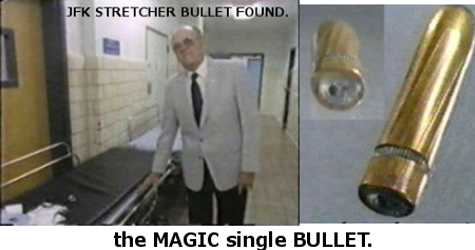 Hospital employee Darrell Tomlinson found a bullet Hospital employee Darrell Tomlinson found a bullet
In 1966, Ray Marcus wrote a very important monograph called The Bastard Bullet. It detailed the journey of the bullet found by hospital attendant Darrell Tomlinson and chief of security O. P. Wright at Parkland Hospital to FBI headquarters on the evening of November 22, 1963. Marcus’ work was exemplary for that time. But since then, and with help from the Assassination Records Review Board, more information has emerged that fills in some of the cracks and crevices in that incredible journey. Specifically this is the work of Gary Aguilar and Josiah Thompson in the essay entitled “The Magical Bullet of the Kennedy Assassination” (The Assassinations, edited by James DiEugenio and Lisa Pease) and two essays at the JFK Lancer site by John Hunt: “Phantom Identification of the Magic Bullet” and “The Mystery of the 7:30 Bullet”. With this new work in mind, let us update the work of Ray Marcus in regard to the impossible journey of CE 399 on the day President Kennedy was shot. Keeping in mind, that as Dr. Cyril Wecht has noted, the Single Bullet Theory is the “sine que non” of the Warren Commission. Without it, the Commission’s verdict collapses and you hae a conspiracy. And without the Commission’s shiny copper coated, virtually pristine CE 399, there is no Single Bullet Theory. 1. CE 399 begins its magical journey at Parkland Hospital. A bullet rolls out from under a mat and lodges against the side of the gurney. (Mark Lane, Rush to Judgment, p. 79) Question: How did it get under the mat? Remember, the Commission will later say this bullet was in John Connally’s body last. No one has ever answered this question. 2. Even Vincent Bugliosi admits that the stretcher it originated from is under question. (Reclaiming History, End Notes, p. 426) But Bugliosi understates the problem here. The weight of the evidence says that the gurney it was found on belonged to neither President Kennedy nor Governor John Connally. (Sylvia Meagher, Accessories After the Fact, pgs. 174-176; Josiah Thompson, Six Seconds in Dallas, pgs. 154-64) It would be a physical impossibility for the bullet to somehow jump from Ron Fuller's stretcher—where Thompson concludes it was found on- to someone else's. 3. When hospital attendant Darrell Tomlinson notices it, the bullet has no blood or tissue on it. (Meagher, p. 173) Yet the Commission will say that this bullet went through two men and caused seven wounds. 4. But yet, it’s even worse than that. Why? Because the Commission will eventually say that the last resting place of this bullet was in the thigh of Governor Connally. How could 1.) The bullet reverse trajectory and work its way out? 2.) How could it emerge out of a wound it already made? Most pathologists will tell you that entry wounds slightly shrink afterwards. 3.) Further, how could it have no blood or tissue on it if it traversed backwards?  5. Tomlinson picks up the bullet at about 1:45 PM and takes it to security officer O. P. Wright. (Thompson, p. 156) Wright is very familiar with firearms since he was with the sheriff's office previously. (ibid, p. 175) Wright gets a good look at the bullet, he notes it as a lead colored, pointed nosed, hunting round. (ibid) This is extremely important since this bullet will change shape and color by the end of its journey. (...) (James DiEugenio, The Impossible One Day Journey of CE 399, 2010)  CE399 in the National Archives Six Seconds in Dallas reported on an interview with O.P. Wright in November 1966. Before any photos were shown or he was asked for any description of #399, Wright said: “That bullet had a pointed tip.” “Pointed tip?” Thompson asked. “Yeah, I’ll show you. It was like this one here,” he said, reaching into his desk and pulling out the .30 caliber bullet pictured in Six Seconds. ( ... )  Wright on CBS, 1967 Wright on CBS, 1967
In a memo to the Warren Commission [C. E. #2011] concerning its investigation of the chain of possession of C.E. #399, the FBI reported that two Parkland Hospital eyewitnesses, Darrell Tomlinson and O. P. Wright, said C.E. #399 resembled the bullet they discovered on the day JFK died. But the FBI agent who is supposed to have interviewed both men and the Bureau’s own suppressed records contradict the FBI’s public memo. Agent Odum denied his role, and the FBI’s earliest, suppressed files say only that neither Tomlinson nor Wright was able to identify the bullet in question. This suppressed file implies the hospital witnesses saw no resemblance, which is precisely what Wright told one of the authors in 1967. (Gary Aguilar and Josiah Thompson, The Magic Bullet: Even More Magical Than We Knew?)
|
|
|
|
Post by Arjan Hut on Jan 17, 2019 11:17:50 GMT -5
19 The Pitzer Film"At 4:30 P.M. Eastern Time on Friday, November 22, 1963, three hours after President Kennedy was shot in Dallas, Lieutenant Commander William Bruce Pitzer received a phone call at his home in Takoma Park, Maryland. Lt. Cmdr. Pitzer was the head of the Audio-Visual Department of the Naval Medical School. In his audio-visual expertise, Pitzer worked closely with Bethesda Naval Hospital, where the president’s autopsy was about to take place. After listening to his caller, Bill Pitzer hung up. He excused himself from his family’s dinner table, and said he was going to work. Pitzer took with him his 35 mm camera. He did not return home until the next afternoon. He did not discuss with his family the work he had done in the meantime. 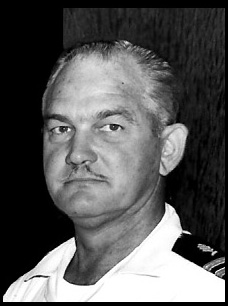 Lieutenant Commander William Bruce Pitzer Lieutenant Commander William Bruce Pitzer
On the Monday or Tuesday following the assassination, First Class Hospital Corpsman Dennis David stopped by the office of his good friend and mentor, Lt. Cmdr. Pitzer. David found Pitzer crouched over a film-editing machine. “Come here,” said Pitzer, “I want to show you something.” As Pitzer hand-cranked a sixteen-millimeter, black-and-white film through the machine, David watched the short movie on a small screen. What he saw was the body of President Kennedy viewed from the waist up, being touched by the hands of unseen individuals. He saw the hands roll the body onto its side and back. Pitzer was editing the film. David watched him work on several reels. He got the impression, he said, that Pitzer “was pulling some of the frames off of the films to make slides with.”In addition to the movie film, Pitzer had pictures and slides on his desk. They showed the president’s body from different aspects. Pitzer shared his photographic evidence with David. The two men talked over what they were seeing. David recalled to an interviewer his and Pitzer’s conclusions: “Number one, it was our distinct impression—impression, hell, it was our opinion, actual opinion—that the shot that killed the President had to have come from the front.” Asked why, David said, “Because we both noted a small entry wound here [interviewer notes that David points to the right side of his forehead] from another photo, and a large exit wound back in this area [indicates right rear of head]. I had seen gunshot wounds before, and so had Bill. I’ve seen a lot of them since, and I can assure you that it definitely was an entry wound in the forehead.” That he and Pitzer were looking at an exit wound in the rear of Kennedy’s head was even more obvious: “It is inconceivable that anyone even vaguely acquainted with gunshot wounds would conclude that the massive wound in the rear of JFK’s skull could have occurred from a rear-entry projectile, unless it was from grenade or mortar shrapnel, which tears and rends flesh and bone rather than pierces it.” Pitzer did not tell David he had taken the film he was editing, but David assumed he had. “I never asked him,” David said. “He was head of the Audio-Visual Department. I just assumed he had done it, he had taken it.” What Dennis David says was on Bill Pitzer’s film contradicts not only the Warren Report but also the increasingly challenged official photographs and X-rays of the autopsy, as well as the questionable testimony of Drs. Humes, Boswell, and Finck. If David is right, the Pitzer film and photographs would constitute powerful evidence of a systematic government cover-up of the gunshot wounds. Pitzer himself would be a critical witness to the process whereby he either took or obtained the government-incriminating movie and photographs of the president’s body. Bill Pitzer was shot to death on October 29, 1966. His body was discovered at 7:50 P.M. on the floor of the TV production studio of the National Naval Medical Center, Pitzer’s working area. The estimated time of his death was approximately 4:00 P.M. As an FBI teletype reported early the next morning, the victim was found dead with a gunshot wound in his head and a thirty-eight caliber revolver lying close to his body. Pitzer’s body was found lying face down “with the head extending under the lower rung of two aluminum step ladders which were leaning against a foundation post.” Following a joint investigation by the Naval Investigative Service (NIS) and the FBI, the Navy ruled that Bill Pitzer had committed suicide. The members of his family were certain that he had not. The Navy investigative board’s verdict of suicide rested on its claim that Pitzer “was experiencing marital difficulty and was intimately associated with another woman.” Bill Pitzer’s friends and family resisted the board’s theory of suicide and Pitzer’s supposed motivation, both of which contradicted their knowledge of the man. (Jim Douglass, JFK and the Unspeakable, s. 314-316, 2008)  "Fort Bragg, August 1965. Green Beret Dan Marvin was approached and asked to carry out an assassination of an American citizen (William Pitzer) who was going to sell sensitive United States materials to the enemy. Bill Pitzer was found shot to death on October 29, 1966. He was about to retire from the navy. An investigation by the Naval Intelligence Service and the FBI concluded that Pitzer had killed himself. FBI files on the investigation, released in 1997 under the Freedom of Information Act, revealed that there was a strong possibility that Pitzer had been murdered. Daniel Marvin is the author of the book, Expendable Elite (2003). He was working on a book about William Pitzer entitled The Smoking Gun: The Conspiracy to Kill LCDR William Bruce Pitzer when he died on 19th January, 2012. " ( Spartacus Educational) Q: One last question, and this is probably repetitive from earlier questions we have. Was there anyone taking any motion picture photographs - A: Negative. Q: - during the night of the autopsy? A: Negative. MR. GUNN: Thank you very much. And how about Mr. Pitzer? Was Mr. Pitzer present at the autopsy? A: He was not present. In fact, I shot his autopsy. Q: Photographed his autopsy? A: Yeah, excuse me. MR. GUNN: Okay. Thank you very much, Mr. Stringer. [Whereupon, at 4:30 p.m., the taking of the deposition concluded.] [Signature waived.] (Page 228 of John T. Stringer's testimony before the ARRB, 1996)
|
|
|
|
Post by Arjan Hut on Jan 17, 2019 11:23:26 GMT -5
19 a The Pitzer autopsy report
Pitzer was found dead just before he was scheduled for retirement after 28 years in the military. Just before his death, Pitzer had been offered a job working for a "network television station" for $45,000 a year. High Treason says: "His family was told that his death was a suicide, and no one in his family believes it. The government refuses to give up a copy of the autopsy report ... His widow stated ... that Pitzer left ... notes for the smallest thing and would have left a suicide note ... His widow said that his left hand was so mangled that they could not remove his wedding ring to give it to her, but he was right-handed. The question is, if he shot himself in his office with his right hand, how could his left hand be mangled?" According to the Waukegan, Illinois, News-Sun on May 1, 1975, Pitzer had taken the JFK autopsy photos and had been threatened repeatedly because of what he had seen. According to Dennis David, a medical corpsman who officially attended the autopsy, "Pitzer filmed in detail the Kennedy autopsy." (Source: Who's who in the Kennedy Assassination) 
|
|
|
|
Post by Arjan Hut on Jan 18, 2019 3:07:07 GMT -5
20 Fourteen minutes recording of Hoover – LBJ phonecall on 23-11-1963
Further reading:183 Tapes of Lee Harvey Oswald calling the Soviet embassy in Mexico CityWhatever Lyndon Johnson and J. Edgar Hoover knew of the plot to kill Kennedy before Dallas will perhaps forever remain in the realm of speculation. Fact is that on the morning after the brutal public execution of JFK, both men knew that the CIA had been preparing a fake link between arrestee Lee Harvey Oswald and foreign communist agents during the last week of September 1963. They then thwarted the CIA's objective of an invasion of Cuba by making the decision, without further investigation, that Oswald was guilty, but acted
alone. There would be no further probing into the true circumstances of the assassination of Kennedy. They discussed this over the phone. A transcript of this conversation survives, but the actual call has been deliberately erased. (AH) LBJ: Have you established any more about the visit to the Soviet embassy in Mexico in September?
Hoover: No, that’s one angle that’s very confusing, for this reason—we have up here the tape and the
photograph of the man who was at the Soviet embassy, using Oswald’s name. That picture and the tape do
not correspond to this man’s voice, nor to his appearance. In other words, it appears that there is a second
person who was at the Soviet embassy down there.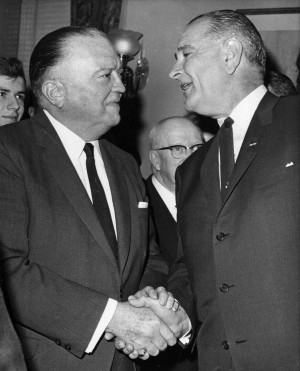 Hoover and Johnson, friends and neighbors in Washington Hoover and Johnson, friends and neighbors in Washington
"I had spent the day before the Lancer conference at the LBJ Library in Austin, and purchased some 17 tapes of LBJ phone calls, a few of them assassination-related. But not included among these was the incredible LBJ-Hoover call of the 23rd, which Newman showed in transcript form. I called the LBJ Library to inquire about whether a tape of this phone call was available. I spoke with library staff member Regina Greenwell, who informed me that yes they did have it, but it was of such poor quality as to be inaudible. Having been impressed by the quite good quality of the other tapes in my possession, and given the import of the conversation, I half-jokingly asked if this was another “18-minute gap.” Several days later the single cassette tape arrived. Imagine my surprise when the first few calls, taped on the evening of the 22nd, sounded perfectly clear (they may indeed be of somewhat lesser quality than the later Dictabelts, but not by much). Then came, according to the printed call log on the cassette label, the 10:01 AM Hoover call. At this point, the tape emits over 14 minutes of silence interrupted only by some kind of “pop” or “beat” about every seven seconds (presumably at the seam where the end of the belt meets the beginning, though that is just a guess). The succeeding conversation, which is denoted as beginning at 10:17 AM, sounds perfectly clear again." The log for side A of this compilation cassette tape is printed below, and only the Hoover call is silent. 11/22/63 9:06 PM Arthur Goldberg 11/22/63 ? (Machine Noise) 11/22/63 9:10 PM Richard Maguire 11/23/63 10:01 AM J. Edgar Hoover 11/23/63 10:17 AM George Meany 11/23/63 1:10 PM Carl Albert 11/23/63 1:15 PM Fred Kappel 11/23/63 1:35 PM Edwin Weisl, Sr. 11/23/63 1:44 PM Ralph Yarborough 11/23/63 1:50 PM Everett Dirksen 11/23/63 1:55 PM Robert Anderson 11/23/63 2:00 PM Mrs. J. D. Tippitt Underlined names denote the beginning of a new magnetic belt. Note that the Hoover conversation occupies its own belt. There is thus the possibility that a blank belt has been substituted for the original. Expert testing could presumably distinguish between this and erasure of the real belt. In any case, the effect and inferred motivation remain the same. (Rex Bradford, The Fourteen Minute Gap, 2000)  Portion of Johnson’s daily diary, available at the LBJ Library web site Portion of Johnson’s daily diary, available at the LBJ Library web site
|
|
|
|
Post by Arjan Hut on Jan 18, 2019 9:35:14 GMT -5
21 Several frames from the Towner film.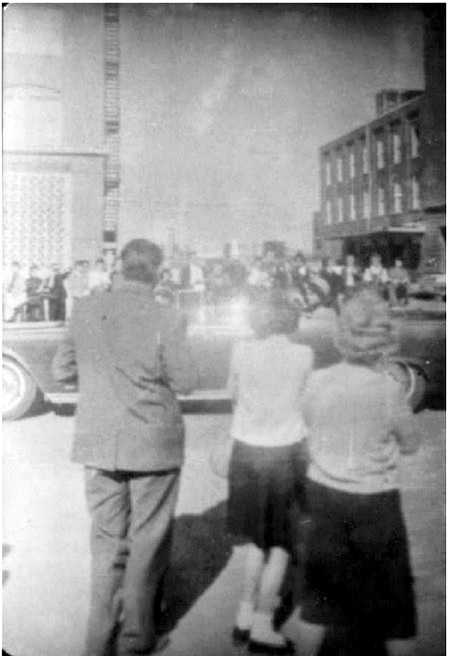 Tina Towner (middle) in Betzner pic Tina Towner (middle) in Betzner pic
As a thirteen year old girl, Tina Towner went to Dealey Plaza with her parents on November 22, 1963 to see President Kennedy. She filmed the motorcade with a movie camera as it turned on to Elm Street. About seven frames are missing from the Towner film. They would have shown what happened between the moment JFK suddenly clenched his fist and (after the cut) shifting back to his right, to an upright position, as if he had dodged something. The frames were apparently damaged and therefore the FBI removed them. Inexplicably, the corresponding frames from the Hughes film, showing the same moment from a further distance, are also damaged. Robert Harris talks about this in The attack in Dealey Plaza, somewhere between 2 and 5 minutes into the documentary:
|
|
|
|
Post by Arjan Hut on Jan 20, 2019 8:36:52 GMT -5
22 Oswald's pre-Dec 1960 CIA-File
Related:112 One CIA memo on Oswald in USSRJames Angleton has been heavily fingered in the story of Lee Harvey Oswald. Angleton had a pre-assassination file on Oswald that was opened - officially, although dates on documents in Oswald's file suggest otherwise - only after the State Department queried CIA about American "defectors" to the Soviet Union. Oswald never actually defected, and after decades of file releases, it now seems Oswald was likely sent to the Soviet Union by the CIA as a false defector as part of a hunt for a mole in the U-2 program. (Lisa Pease, A Lie Too Big To Fail, 2018)  ANGLETON and CI/SIG opened an OSWALD dossier, or 201 file only because it was forced to do so. ANGLETON wanted as little a paper trail between him and OSWALD as was possible that was one reason why OSWALD’S documents were sent to the Office of Security. No CIA documents existed on OSWALD until his 201 file was opened on December 9, 1960. David E. Murphy, Soviet Russia Division Chief, was told by Allen Dulles that "Warren Commission members could not understand why CIA had not begun an investigation of OSWALD as soon as it received word that he had defected." Some component other than CI-SIG should have opened a 201 File on OSWALD immediately after he threatened to give military information to the Soviets but ANGLETON took over the investigation. ( Coup d'etat in America, Nodule X6, 2010 edition)  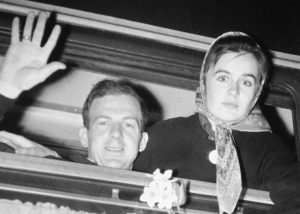 James Jesus Angleton James Jesus Angleton (The "Jesus" is silent) When JFK investigators asked Angleton and retired CIA director Richard Helms about the 12 month delay in opening of Oswald’s 201 file, neither man could explain it. Testifying under oath to the HSCA in October 1978, Angleton pleaded ignorance. “I don’t know the circumstances,” he said, which was almost certainly not true. Angleton did know the circumstances of Oswald’s defection because it was reported in the Washington Post and his aide Jane Roman wrote several memos about it. ( JFKfacts.org)
|
|
|
|
Post by Arjan Hut on Jan 21, 2019 3:59:03 GMT -5
23 The Emergency Codebook on the SAM86972 (The Tokyo Flight)On November 22, 1963, most of President John F. Kennedy’s cabinet were in an airplane (SAM 86972, a modified Boeing 707.) over the Pacific on their way to Japan for a regional conference, including Secretary of State Dean Rusk, Secretary of the Treasury Douglas Dillon, Secretary of Interior Stewart Udall, Secretary of Commerce Luther Hodges, Secretary of Agriculture Orville Freeman, Secretary of Labor Willard Wirtz and Press Secretary Pierre Salinger. When the news from Dallas came over the telex, the cabinet members relied on a pre-set protocol to handle the situation accurately. 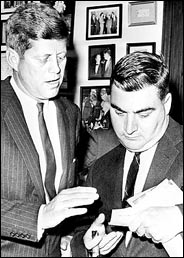 (JFK and Salinger) “Aboard every presidential jet there is usually a White House codebook. We searched for it for about five minutes, but there was none aboard this plane.” (Salinger)  SAM 86972 in Vietnam, 1966 SAM 86972 in Vietnam, 1966“And that was the extent of the missing code book crisis. The code book should not have been missing, but its absence, which proved to be of no real consequence, does not by itself mean something sinister.” (Ronald L. Ecker, The Tokyo Flight - Coincidence or Conspiracy?)
|
|
|
|
Post by Arjan Hut on Jan 21, 2019 4:23:23 GMT -5
24 Emergency codebooks on Strategic Air Command bombers on 22-11-1963John Judge, the director of COPA – the Coalition on Political Assassinations, attended the University of Dayton, in Dayton, Ohio, also the home of Wright-Patterson Air Force Base. While there in the 1970s, Judge was a guest at the Wright-Pat Officers Club, where he talked with an officer who said he was a Strategic Air Command pilot of a nuclear armed B-52 during the Cuban Missile Crisis and when President Kennedy was killed. Then on the day JFK was assassinated, they were in the air on their regular shift that maintained a fleet of armed bombers in the air on a 24 hour basis. When they learned that the President had been shot, over civilian commercial radio, they thought they would receive new orders and in preparation for that they opened the plane’s safe to get the code books that are needed to translate and confirm any orders, and it was missing. (JFK Countercoup "Stranger" & the Missing Code Books on 11/22/63", Sunday, May 20, 2012)  Wright-Patterson Air Force Base Wright-Patterson Air Force Base
|
|






















 (JFK and Salinger)
(JFK and Salinger)
